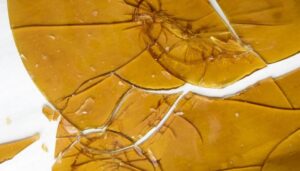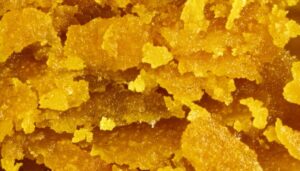Shatter is a cannabis extract that is known for its unique appearance. When it first emerged on the market in the early 2010s, it quickly became popular among photographers and Instagram users — and there’s no surprise why. Shatter, commonly known as shatter weed, marijuana shatter, or shatter wax, is unlike any other marijuana product on the market. Shatter is a translucent material that resembles stained glass; it isn’t completely transparent, and it isn’t totally opaque. It has a brittle consistency that shatters like glass when broken, and its hue varies from dark ambers and honey-like tones to lighter yellows ranging from vegetable oil.

What Are Cannabis Concentrates?
Dabbing enthusiasts enjoy cannabis concentrates because these products offer a more powerful and faster-acting high while keeping the plant’s natural flavor profile, known as a macrodose. Shatter and other cannabis concentrate items are produced by slow and careful processing of cannabis plant material with solvents.
Manufacturers first use a solvent to remove the cannabinoids and other compounds from cannabis plants during extraction. Terpenes (the chemicals that give cannabis flowers their unique scents and other qualities) as well as cannabinoids (THC, THCA, and CBD, to name a few) are contained in the oils extracted from cannabis plants. Cannabis concentrates are extremely potent, with THC concentrations ranging from 90% to more than 99%. Depending on how the cannabis oils are extracted and handled after extraction, marijuana concentrates assume a variety of forms.
What is Shatter?
Shatter is a potent form of cannabis. Butane hash oil (BHO), often known as honey oil, wax, sap, or budder, is the name given to this concentrate by various street names. When broken down, the term “shatter” refers to the concentrate’s consistency and appearance. Shatter has an amber color and a glass-like clarity when broken down.
Shatter, in its pure form, is well-known among cannabis consumers who want a stronger version of the drug. Shatter is quite powerful, with THC concentrations ranging from 60% to 80 percent. Certain extremely potent kinds of shatter have been discovered to contain up to 90 percent CBD or even 99 percent CBD. The majority of today’s cannabis is burned and used in non-concentrate form, resulting in a greater THC concentration. Although marijuana consumers’ demands for a higher and more powerful high are constant, typical everyday cannabis has an average THC level of around 20 percent or less. Anything over 20 percent is considered unusual.

Because marijuana in its natural form has up to 20% THC, inexperienced users should be aware that it is rather potent. Those who are more knowledgeable with cannabis may want something stronger from their marijuana fix. Adventurers and individuals searching for a unique sensation may use shatter as a means of pushing themselves to the limit and experiencing an unusual feeling.
The manufacturing process for shatter is one of the most unusual and distinctive elements of the substance. To transform marijuana components like cannabinoids and terpenes from a cannabis plant, BHO must be manufactured using butane, a highly inflammable and readily liquefiable gas that is also quite psychoactive. To create the concentrated solution present in BHO, extraction is utilized. Cannabis plants produce these chemicals naturally. When particular receptors in the brain are activated, individuals feel comfortable, calm, and euphoric while also alleviating discomfort.
What’s The Difference Between Concentrates, Extracts and Dabs?
The names given to these items vary. Concentrates encompass all goods that have been extracted from the plant. Extracts and concentrates are sometimes synonymous, although some people differentiate extracts as those produced using solvents but not those obtained via non-solvent techniques. Products created only from butane hash oil might be referred to as dabs; nevertheless, the term is occasionally used metaphorically for concentrates produced in a variety of ways. There are other post-production strategies that result in a different set of products and terms.
Is It Dangerous to Make Solvent-Based Concentrates?
The preparation procedure itself might be hazardous when solvents are utilized to create concentrates. Several people who used butane to make extracts at home have started fires and explosions, resulting in severe burns. In 2015, researchers from the University of Colorado conducted a study on the consequences of marijuana legalization in Colorado, which revealed that during a two-year period, the University of Colorado burn center treated an increase in flash burns caused by THC extraction using butane, with some affecting more than 70% of body surface area and most requiring skin grafting.
It’s illegal to make BHO in the United States, and it’s unlawful even in states where marijuana is permitted for adult use, such as Colorado and California, to do so with flammable liquids. In Colorado, state officials recommend using nonflammable dry ice (CO2), ice water, or buying the product from a licensed marijuana retailer instead of using flammable liquids. Commercial production facilities, by and large, employ a more secure extraction technique that prevents solvents from being wasted or exposed to the open air where they may be ignitied, similar to traditional systems employed in the manufacture of many commercial goods for decades.
What Are Cannabis Extracts?
Cannabis concentrates are a type of medicine that include cannabis plant extracts such as marijuana and hemp. THC and CBD are two well-known cannabinoids present in these mixes. Hemp extracts will contain a greater amount of CBD while cannabis ones will have more THC.
Cannabis extracts are produced by soaking finely crushed cannabis material in a solvent. Live resin is sometimes produced from fresh flowers. CO2 and other solvent alternatives such as butane, hexane, and others are used, although if not properly vented they can be dangerous. These solvents work by extracting the THC from the plant and concentrating it. It’s not a huge problem because it takes so long to complete the process.
Why Is Shatter Called Shatter?
“Shatter” is a term used to characterize the extract concentrate’s texture and appearance. Shatter is a bright yellowish liquid with a silvery sheen that appears to shatter when broken into pieces. As a result, it was named because it resembles glass shattering when shattered.
What Is Shatter High Like?
Shatter is well-known and notorious for its capacity to deliver a quick and powerful high. To put it another way, it’s a technique for getting higher more quickly. It’s possible to consume too much of anything, especially if you’re not used to the effects of shatter. Shatter contains terpenes rather than cannabinoids, which some users claim gives the extract (and dabbing) a more refined concentrate end result.